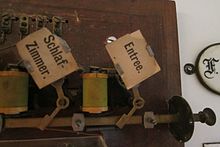Drop flap

The drop flap is an optical, sometimes also acoustic, electromagnetic display device, for example with a bell, that provides information about certain functions or an operating status of a technical system, such as malfunctions, errors and power outages. The historical model shown in the picture is brought back to its starting position by a permanent magnet when the current is interrupted. Other drop flaps are returned to their initial state by manual acknowledgment, for example by pressing a button.
Function and use
An electromagnet either attracts an armature when a current is flowing , which releases the lock on a flap and causes it to fall, or the lock is released when the current flow is interrupted. In order to trigger the drop flap, only one impulse (brief application or removal of voltage) is necessary.
In the early days of telecommunications technology , the drop flap was used for hand-switched calls to visually signal to the operator that a participant wanted to connect or disconnect a call . The indicator functions in a technically similar manner , but only displays when voltage is present.
Drop flaps were also used in electrical call systems in stately homes, office buildings and hotels. Several drop flaps in a wooden box, the room panel, could be operated via cables by electric bell buttons or pulls and thus summon staff or employees. Also on Neuschwanstein such an electric call system in addition to other technical equipment was installed.
The drop disc is a special form of the drop flap . This is a signal disc that was used on certain railways when they were ringing. If an electrical impulse sounded the chime of the bell , a pawl was released and the signal disc rotated from the horizontal to the vertical due to the gravity of a counterweight, indicating that a train was approaching, for example. Postponed, i.e. acknowledged, was done by hand.
literature
- Carl Beckmann: Telephon- und Signal-Anlagen A practical guide for the construction of electrical telecommunication (low-voltage) systems . Springer, Berlin / Heidelberg 1923, OCLC 913686664 , p. 53 .
- Karl Strecker : Auxiliary book for electrical engineering . tape 2 . Springer, Berlin 1928, OCLC 907813879 , p. 671 ( books.google.de ).
Web links
Individual evidence
- ↑ Herz's magneto-electric bell and flap. In: Polytechnisches Journal . 258, 1885, pp. 215-216.
- ↑ website of the phone collection EREL
- ↑ Georg Walterspiel: Introduction to Hotel Business Management , Wiesbaden 1969, ISBN 978-3-663-00469-1 (reprint), p. 52 f.
- ↑ Website of the Bavarian Palace Administration with a description of the facility
- ↑ Internet page that explains such bells ( memento of the original from March 10, 2016 in the Internet Archive ) Info: The archive link was automatically inserted and not yet checked. Please check the original and archive link according to the instructions and then remove this notice.


